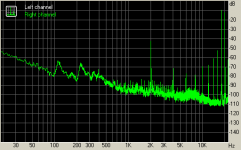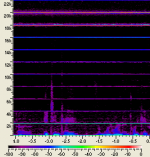I've just given you three samples of binaural recordings that proves it doesn't work because the sound turns with your head and what you hear is not what you would at a real musical performance. But don't take my word for it, here's an example of an attempt to solve this problem using a "head tracker" and multiple binaural recordings made at the same time using the head tracker to switch between them. (That's also an old idea and there are others.) The relevant part starts about 3:32 into the presentation.
AES Tutorial: Binaural Audio Technology?History, Current Practice, Emerging Trends by Bob Schulein - YouTube
Your examples just prove that generalized HRTFs don't work well for you and me. Nothing more. Replacing own experience with the opinion of someone else is never a good idea.
I've heard this before. It's about as effective demo as it can get from binaural recording. Very suggestive but if you listen carefully the sound is confined to a space from just beyond one ear to just beyond the other. Now show me one where a musical performance is in front of you and you hear the immense space of a concert hall or cathedral.
You would need to do your own recordings. Sorry but that's what it takes.
That one works quite well for me, I even get some sense of front/back although front/back is still not as clearly defined as real life. The main problem for me with that and many other binaural recordings is that the height is wrong.By the way, here's a "generalized HRTF"-example that works better for me. Externalization is very good but the typical front-back reversal.
I feel like I'm sitting on a child's stool with the voices around me coming from about 20 degrees above me
Another thing I would say about binaural recordings is that they work MUCH better with actual in-ear canal earbuds than they do with normal headphones. In the former case you're coupling directly to the ear canal without any effects from the pinna, with normal over ear or on ear headphones the pinna has some effect, effectively modifying the response twice. (Once by the dummy head pinna or virtual pinna during the recording process, a second time by your own pinna)
That same recording with normal over ear headphones doesn't sound anywhere near as convincing to me as with in-ear ear buds.
Last edited:
That one works quite well for me, I even get some sense of front/back although front/back is still not as clearly defined as real life. The main problem for me with that and many other binaural recordings is that the height is wrong.
I feel like I'm sitting on a child's stool with the voices around me coming from about 20 degrees above meAs elevation is influenced a lot by the frequencies around 8Khz I suspect it could be a response peak with my earphones to blame for exaggerated height perception.
Another thing I would say about binaural recordings is that they work MUCH better with actual in-ear canal earbuds than they do with normal headphones. In the former case you're coupling directly to the ear canal without any effects from the pinna, with normal over ear or on ear earphones the pinna has some effect.
That same recording with normal over ear earphones doesn't sound anywhere near as convincing to me as in ear ear buds.
The virtual barber demo doesn't work for me at all with some cheap in-ears but much better with a Stax. This proves to me that for some people the sound field needs to be very exact to be convincing. Even then for untrained listeners the sense of sight might win over hearing and one gets the typical front-back reversal.
Front/back disambiguation on a binaural recording (where head movement isn't a possible disambiguation cue) is entirely frequency response derived - eg the cone of confusion et al.The virtual barber demo doesn't work for me at all with some cheap in-ears but much better with a Stax. This proves to me that for some people the sound field needs to be very exact to be convincing. Even then for untrained listeners the sense of sight might win over hearing and one gets the typical front-back reversal.
All it takes is a small error in a critical frequency region related to front/back disambiguation to make the brain to think "huh?" and cause the illusion to be smashed.
So not only is the necessary HRTF response different for each individual listener, the frequency response of the earphones you're listening with is absolutely critical.
Anyone who has listened to enough different headphones/earphones will know that the variations in frequency response from one model to another are HUGE until you get quite pricey....(and even then) so getting a good binaural result is a bit of a pot luck chance depending on your earphones/headphones.
so getting a good binaural result is a bit of a pot luck chance depending on your earphones/headphones.
I would even say that HRTF individualization and headphone response compensation is a must. The Smyth Realiser does both.
Front/back disambiguation on a binaural recording (where head movement isn't a possible disambiguation cue) is entirely frequency response derived - eg the cone of confusion et al.
All it takes is a small error in a critical frequency region related to front/back disambiguation to make the brain to think "huh?" and cause the illusion to be smashed.
So not only is the necessary HRTF response different for each individual listener, the frequency response of the earphones you're listening with is absolutely critical.
Anyone who has listened to enough different headphones/earphones will know that the variations in frequency response from one model to another are HUGE until you get quite pricey....(and even then) so getting a good binaural result is a bit of a pot luck chance depending on your earphones/headphones.
"All it takes is a small error in a critical frequency region related to front/back disambiguation to make the brain to think "huh?" and cause the illusion to be smashed."
This is rediculous. If what you said were true, a different piano or violin with a different tone and different spectral content would change the spatial perception at a live concert radically. My experience is that it doesn't change it at all. What's wrong with the binaural recording principle is.....sorry, I can't tell you that, you'll have to figure it out for yourself. I've concluded it can't be made to work with any headphones or filters.
BTW I've heard Ralph Glasgal's demo and you can too on his ambiophonic website where binaural recordings are made to be played through speakers. It creates an interesting perception of the source between you and the loudspeakers over a wide flat line that can be nearly 180 degrees but it does not recreate concert hall acoustics. And it cannot place the sources at great distance from you, at least not in the examples I heard. In listening to Choueiri's demo with the teleconference room, to test the effectiveness of the process it's best to not look at the video but listen only to the audio. Edgar Choueiri's thesis is that he's corrected for severe spectral distortion in the binaural recording though speakers technique that the Glasgal process creates. Note his best setup is in an anechoic chamber and I'm sure the listener and speakers are carefully positioned. BTW, I didn't notice that the bee was buzzing around my head. With eyes closed it was just between the outside of one ear and the other just like the barber shop demo. No frontal depth and only a slight suggestion of depth behind me.
What's wrong with the binaural recording principle is.....sorry, I can't tell you that, you'll have to figure it out for yourself. I've concluded it can't be made to work with any headphones or filters.
There's nothing wrong with the binaural recording technique. You just never heard it done right. There's nothing for us to figure out but something for you to explore.
The binaural principle is simply how our hearing works. Binaural recordings are commonly used in psychoacoustic studies. On a side note, some people hear better with other peoples ears (see Blauert, "Spatial hearing").
This is rediculous. If what you said were true, a different piano or violin with a different tone and different spectral content would change the spatial perception at a live concert radically.
That doesn't make sense. The aural space doesn't change when a different sound is played. All spatial cues are still physically correct. Response variations in the reproduction chain of a binaural recording have a much bigger impact. This is what causes the binaural illusion to break down. There are also other factors.
There's nothing wrong with the binaural recording technique. You just never heard it done right. There's nothing for us to figure out but something for you to explore.
The binaural principle is simply how our hearing works. Binaural recordings are commonly used in psychoacoustic studies. On a side note, some people hear better with other peoples ears (see Blauert, "Spatial hearing").
There is clearly something critically different between the soundfields that reaches your ears from real music and the soundfields that reaches your ears from headphones playing binaural recordings. As I posted earlier, figure out what it is and why it matters and you'll know a lot more about the physics of sound and the psychoacoustics of hearing than you think you do. I'm glad this is sufficient for you but for many others it is not or it would have been very widely used instead of stereophonic sound. It's been known and the technology to do it has been around for a very long time.
Okay, back on topic:
If I played a "from the board" recording of our rock band through my EV Sentry IVs it sounded pretty realistic if I disconnected the HF horns (Peavey SP-1s don't have tweeters.)
Another advantage to no tweeters is no tape hiss... oh, I'm showing my age again, aren't I?
If I played a "from the board" recording of our rock band through my EV Sentry IVs it sounded pretty realistic if I disconnected the HF horns (Peavey SP-1s don't have tweeters.)
Another advantage to no tweeters is no tape hiss... oh, I'm showing my age again, aren't I?
My ranking follows Simon's. I was surprised that I heard the 18K bump. I can't hear that high! But some of the bump goes down as low as 15-16K. Maybe what I'm hearing.
I hear a difference in the noise for the whole second. Didn't pay attention to the transition, but it's probably audible too.
I'm just surprised because I can't hear pure tones that high, and I can't hear noise that is very steeply high passed above about 15K. So I don't know why I can hear this. Does having the low end content help me hear the high end? Or is it something else?
I've done tone test (for other reasons) with noise behind it about 30dB down. It helps me identify the tone better than just a tone alone.
Hi Dave,
just downloaded the files and I could hear a difference even in the 18kHz file. This is rather unexpected because neither my hearing nor my Nathans work that high anymore. So it's either expectation bias or some other effect. Could you upload the uncompressed files?
Have you guys thought any more about why you can hear a change when you think you shouldn't be able to ?
The possibilities I can think of are:
1) You're just hearing the increase in response at a lower frequency at the lower skirt of the peaking filter. +6dB is a big shift so even with the Q chosen there could be significant increase in your audible range. Perhaps another set of tests with a lower amplitude shift and higher Q would help establish this.
2) There is some kind of aliasing in the PEQ processing that is folding back a small but audible change into your audible spectrum - Dave did say that when he tried to do a PEQ at 20Khz that he was getting a weird effect something like this, so I am a bit suspicious of the quality of CoolEdit's PEQ when used close to the nyquist frequency. A possible solution would be to do all the processing and filtering at 88.2Khz and then resample down the final result after processing but before MP3 encoding, but then we would need to check that CoolEdit's downsampling algorithm was good. (Many aren't)
3) MP3 is a perceptual codec, and one of the things it relies on is perceptual masking of adjacent frequency bands. It's possible that introducing a large increase in one frequency band will cause modifications in the band below it due to the MP3 encoding process itself, which you may be hearing. (MP3 isn't designed to encode pink noise like signals, and may become "confused", introducing audible artefacts) The solution for that of course is FLAC or similar.
4) Maybe your ears are just better than you think.
I think its still interesting to try and figure out why some of you are hearing what you think you shouldn't be able to - I'm satisfied that I can hear the 18Khz peak because the bottom half of the bell curve will be within my hearing range, but for those of you who say your hearing doesn't go as high, it is a bit of a mystery.
Interesting that many people went into this expecting they wouldn't hear any change in some of the tests but found it a lot more audible than they expected.
Last edited:
I think that's the case for me. When I did higher Q bumps, I could not hear it. Did discover that I can hear sines up to about 15KHz (just), so I'm not as deaf as I thought.1) You're just hearing the increase in response at a lower frequency at the lower skirt of the peaking filter. +6dB is a big shift so even with the Q chosen there could be significant increase in your audible range. Perhaps another set of tests with a lower amplitude shift and higher Q would help establish this.
A curious artifact of software or hardware is that when I generate a pure sine at >14KHz in a 44.1KHz sample rate, I hear it great. But it's much lower sounding, like in the upper midrange. Generate the tone in a 96Khz sample rate file and that goes away. Gotta figure out what is causing the "Wolf Tone" at 44.1KHz sample rate.
After the wider (Q of 2) bump at 20k was clearly aliasing I took more care with the second group and I'm pretty certain the mp3s are good. Cool Edit also has a spectrum analyzer and the spectra looked the same for the mp3 as for the raw file.
Note that the aliasing effect is in the filter calculation. There is a graphical representation of filter shape prior to its implementation and it folds downward as it approaches 22k.
I'm pretty sure the answer is that we hear the width (skirts) of a practical peak filter. As I mentioned, my sense of the peaks pitch died by 11k but I had no problem hearing the 14 k version. What Q and height is most representative of a typical tweeter abberation?
David
Note that the aliasing effect is in the filter calculation. There is a graphical representation of filter shape prior to its implementation and it folds downward as it approaches 22k.
I'm pretty sure the answer is that we hear the width (skirts) of a practical peak filter. As I mentioned, my sense of the peaks pitch died by 11k but I had no problem hearing the 14 k version. What Q and height is most representative of a typical tweeter abberation?
David
I'm sure the measurements section of many of the stereophile "high-end" speaker reviews would provide ample fodderGood question David, let's look around to see what we find.
I've seen some pretty scary looking frequency response graphs there including nasty looking >10Khz treble responses on some very expensive units that received favourable reviews....
(It actually surprises me how often speakers that measure very un-flat still get good comments in the objective/measurements part of the review, let alone the subjective part...)
I might have a browse through some of their reviews when I get a chance and pick a few offenders as samples.
One thing with driver resonances though - they're often not nice simple bell shaped curves, depending on the cause its often a notch, or a peak followed by a notch or vica versa, which I think is more objectionable sounding than a smoothly contoured bell shaped curve.
Pano,Art, I wondered what happened to your test. New things to think about! Looking forward to your findings.
In post # I wrote that HF content that is above our hearing perception can still be perceived as beat frequencies (heterodyning) if it is reproduced properly.
The frequency of beating between very high frequencies may be audible even though the fundamental tone is not.
In post # 44 Speaker Dave dismissed my statement, writing:
”The arguement about beat tones is irrelevant since beats will only come about as a result of nonlinearity. If they existed in the performance then the audible effects would exist and should be recorded. After the original performance they have no place. A system that reveals supersonic frequencies via sonic beats is exhibiting an undesrable distortion artifact (and would be better served with a restricted bandwidth input).”
Dave expands in post # 98:
Supersonic tones can only intermodulate and generate audible tones if there are appropriate nonlinearities present....
p.s. I assume Earl (Geddes) was referring to the 1 Hz (or 40Hz) difference frequency rather than 440.”
Earl writes in post #116:
“The technique was first used for sonar, under water. It uses the nonlinearity of the waves propagation to create this effect. (And no air is not nonlinear enough at audible levels to create this effect between a 17,000 Hz tone and a 17,440 hz tone, which does have a "beat" frequency of 440 Hz.)
The audible devices use very high intensity sound modulated about 50 kHz to create LF difference tones. But this is done in the very near field of the transducer where the nonlinearity will be significant enough to create an audible difference frequency.”
Pano agrees with Earl in the next post, Earl replies he got one or two things right.
Although I agree that the tones would be present in a recording using field microphones picking up multiple instruments, modern studio practice often records individual instruments in isolation, the individual tracks then “panned” across the stereo speakers. In this type of recording, the sources only “come together” through the reproduction transducers.
Not wishing to argue a point that I had no actual test data to back up, I conducted a series of tests to determine whether my observation was indeed correct.
As much as I agree with much of David, Earl and Pano’s assessment, my test below using standard drivers and horn technology proves at least a few of “those things” are wrong.
When two tones are presented to a HF compression driver, a sub harmonic is generated at a frequency that is the difference between the two tones, for instance 2093 (a “C” note) & 3729 (a B flat note) Hz tones produce a distortion component at 1636 Hz, somewhere between a G and G sharp note.
Not good, but the 1636 Hz distortion tone is so far below the other tones in level it does not seem to present an audible problem.
A sub harmonic of 16 kHz and 20kHz (both of which would be inaudible to me and lots of other fellows of a mature age) is at 4K, where ears (without noise induced hearing loss) are most sensitive.
Tests of a half dozen different HF drivers proved that the 4 kHz sub harmonic distortion was also quite low using a dual sine wave tone of about 4 volts . (-20 output level in Smaart, Crest CC2800 at “0 dB”, X20 gain setting).
The sum of two different signal powers is roughly + 3 dB if the two powers are equal . The dual sine wave tone presents about 2 watts, 1 watts at each frequency in to the nominal 16 ohm load.
Screen shots below show the 4 kHz sub harmonic of the BMS 4552 over 32 dB down from the fundamental tones, about 2% distortion.
The BMS 4550, having less 20 kHz output, generated a 4 kHz sub harmonic 48.4 down from the 16 kHz level, less than .5% distortion. The dual sine wave tones were at two meters.
It should be noted that the Maltese horn used for the tests is a conical horn of 13 degree dispersion (-6 dB points above 2.5K) , so it is about six dB louder on axis than “typical “ horns.
The test:
Beat tones were generated using a 20 kHz sine wave from the Smaart generator, lower tones generated from a BK Precision 3011 B 2MHz Function Generator.
B&K 4004 microphone 22.5” on axis from each horn, using Panasonic SV3800 for some gain, it’s digital output recorded with an Alesis Masterlink, the Redbook CD recording then transferred to Logic Pro 7, then bounced to MP3.
The recordings are made full scale, the beat tones and my vocal explanations are some 35 dB below the VHF tones, I would suggest a playback level at least 12 dB down from “normal” to start with.
The MP3 does not seem to have reduced the VHF level from the original recording, those of you with hearing to 20 kHz will find the recordings quite nasty.
If you have access to a high filter, cutting above 15K would reduce stess on the playback system and your ears.
The files with “.zip” are actually MP3, change the suffix to open them.
Sine wave level was -14, about 8 volts, 8 watts in to a nominal 16 ohm load.
The dual sine wave tone would be about 16 watts.
16K50 16000 Hz through BMS 4550 (103.4 dB)
20K52 20000 Hz through BMS 4550 (103.2 dB)
16K20Kcombo 16K and 20K combined response (two separate horn drivers recorded by the B&K microphone)
4K 71.6 dB, 8K 54.7dB, 12K 57.9 dB, 16K 103.9, 20 K 104.0
52dsVHF (16 kHz & 20 kHz) 4K 60.6 dB, 16K 104.7 dB, 20K 95.7 dB,
50dsVHF (16 kHz & 20 kHz) 4K 56.4 dB 16K 104.8 dB, 20K 94.5 dB
17K50 17000 Hz through BMS 4550
17K20Kcombo 16K and 20K combined response
3K 70.4 dB, 14K 55 dB, 17K 102.5 dB, 20K 104.2 dB
18K50 18000 Hz through BMS 4550
18K20Kcombo 16K and 20K combined response
2K 70.3 dB, 14K 53.2 dB, 18K 104.8 dB, 20K 104 dB
19K50 19000 Hz through BMS 4550
Recordings of each combo, and tone sweeps were done with the BMS 4550 from 15K up to around 20K.
Although it may be said that a beat tone 35 dB below the (inaudible) fundamental is too low to be considered, I have witnessed many orchestral and big band conductors “call out” one out of tune player quite some distance away. While the beat frequencies I recorded are certainly no proof that everyone would benefit from frequency response above their HF frequency threshold, I have no doubt some can perceive the difference that is clear in both the screen shots and the audio recordings.
Many recordings were made, in one a frequency of beating at 100 Hz , the difference of 19900 & 20000 Hz is clearly audible with a high flying jet and bird noises also in the background.
This test proved my point better than expected, I had tried a similar experiment years ago, but the horn/driver combination I used was not up to the task.
The BMS drivers on Maltese horns were.
Art Welter
Attachments
-
18&20K2HornCombo.zip239.7 KB · Views: 50
-
18&20K2HornHand.zip574.9 KB · Views: 50
-
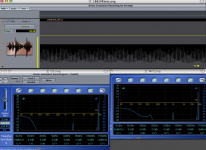 Tone Veiw.png192.3 KB · Views: 351
Tone Veiw.png192.3 KB · Views: 351 -
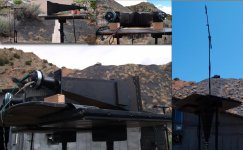 BeatTest.jpg99.8 KB · Views: 349
BeatTest.jpg99.8 KB · Views: 349 -
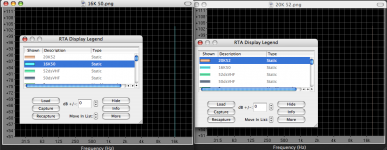 1Horn1tone,16&20K.png106.5 KB · Views: 347
1Horn1tone,16&20K.png106.5 KB · Views: 347 -
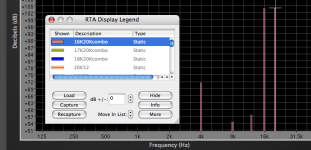 16&20Kcombo.png68.2 KB · Views: 340
16&20Kcombo.png68.2 KB · Views: 340 -
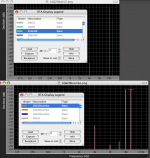 16&20Kone&2 horns.png130.6 KB · Views: 342
16&20Kone&2 horns.png130.6 KB · Views: 342 -
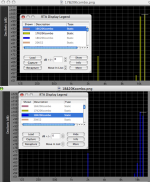 17&20,18&20Kcombo.png184.1 KB · Views: 59
17&20,18&20Kcombo.png184.1 KB · Views: 59
Thanks Art! There is certainly a lot more going on there than just the two high tones. See my shots below.
Would be interesting to know what the output of the amp looks like at the driver terminals, and also at the terminals of a 16R resistor. I.E., how much is the source, how much the driver, how much the tones in the horn throat. Some real promising stuff there that we amateurs rarely get to see.
Would be interesting to know what the output of the amp looks like at the driver terminals, and also at the terminals of a 16R resistor. I.E., how much is the source, how much the driver, how much the tones in the horn throat. Some real promising stuff there that we amateurs rarely get to see.
Attachments
- Status
- This old topic is closed. If you want to reopen this topic, contact a moderator using the "Report Post" button.
- Home
- Loudspeakers
- Multi-Way
- What are benefits of adding HF driver 7khz up?
